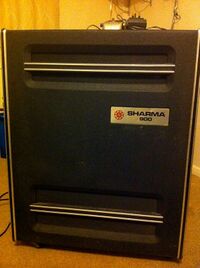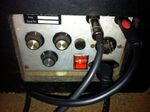Engineering:Sharma speaker
The Sharma speaker was a rotary speaker, similar in design to the Leslie speaker, that was manufactured in the UK by Keith Hitchcock during the 1960s and 1970s.[1][2]
History
The name "Sharma" came from Hitchcock's two children, Sharon and Mark.[3][unreliable source?]
Hitchcock designed the speaker to directly compete with the Leslie, and consequently it contains similar features, such as a rotating horn for treble frequencies, a drum for bass frequencies, and the same nine-pin amphenol connector interface as contemporary Leslies then in production. However, unlike a typical Leslie, it includes a treble and bass control, and a line level input.
Also, in the Leslie units the horn and bass rotor moved in opposite directions, with a fast and slow motor on each. In the Sharma units, they both rotate in the same direction, with just a fast and slow motor shared. A clutch allows the top and bottom rotors to accelerate at different rates.
The amplifier boards were made for Sharma by HH Electronics.[citation needed] Some of the early Sharma speakers had an eight-pin connector. Some models of speaker also contained rotary and stationary speakers, with separate power amplifiers, which were used on non-Hammond organs such as Lowrey or Wurlitzer.[4]
Sharma speakers fell out of favour due to the introduction of low-cost electronics that could emulate the rotating speaker sound.[citation needed]
References
- ↑ "Hammond FAQ : Question 20". http://midiguru.net/hammond.htm. Retrieved 8 October 2012.
- ↑ "Lesley not not the woman? the speaker!". http://forum.speakerplans.com/lesley-not-not-the-woman-the-speaker_topic31794_page3.html. Retrieved 8 October 2012.
- ↑ "alt.music.hammond-organ : Sharma". https://groups.google.com/group/alt.music.hammond-organ/tree/browse_frm/month/2002-05/35da1deab8323377?rnum=21&_done=%2Fgroup%2Falt.music.hammond-organ%2Fbrowse_frm%2Fmonth%2F2002-05%3F.
- ↑ "Organ Forum : Can I change the crossover frequency in my Sharma speaker?". http://www.organforum.com/forums/archive/index.php?t-19747.html. Retrieved 8 October 2012.
 |



